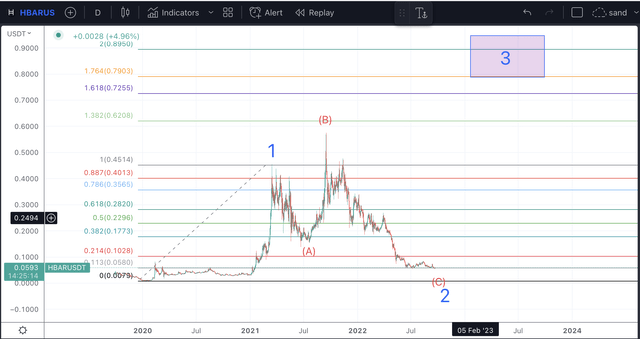
AerialPerspective Works
Overview
Hedera Hashgraph (HBAR-USD) is an energy-efficient, fast and scalable enterprise-grade public network. Hedera is not your typical blockchain project; it runs an entirely different network architecture from a blockchain.
Blockchain networks are the most popular implementations of Distributed Ledger Technology (DLT). DLT is a distributed system of keeping and sharing records between network nodes, with no central data source or authority in the network. Blockchain networks have been faced with “The Blockchain Trilemma”, which is a belief that in decentralization, security, and scalability, a blockchain network can only effectively provide two of these three benefits. Layer-1 blockchains are in a race to solve “The Blockchain Trilemma.”
Hedera uses a DLT known as a Hashgraph. A Hashgraph utilizes a Directed Acyclic Graph (DAG) in its architecture, unlike a blockchain which stores data in a linear, append-only pattern called blocks. According to Hedera, the Hashgraph enables decentralization, high security, and high scalability. In both a blockchain and a Hashgraph, every node on the network obtains an exact copy of data, which guarantees immutability.
Hedera’s Technology and Governance
Hedera uses the “gossip protocol” to broadcast transactions and achieve consensus. When a node in the network receives new data, it randomly chooses another node on the network and shares this new data; the next node that receives the new data further chooses another node randomly. This process is repeated until all nodes on the network possess the new data. When the sharing of data with peer nodes is complete and finite, an event is created and time stamped into a data structure.
Hashgraph technology solves the same problems that blockchain technology solves. However, Hashgraphs tend to be faster in transaction processing. The Hedera network boasts the capability to process over 10,000 transactions per second. Transactions on Hedera are confirmed within three to five seconds, with finality.
In Hedera, there are no miners; therefore, the transaction fees are usually very low. Network congestion also does not affect transaction fees, unlike in proof-of-work blockchains, where a busier network means a higher transaction fee. The very low fee for processing transactions on Hedera makes it attractive for enterprise use and for developing mission-critical applications.
Hedera Hashgraph claims it has achieved the highest level of security a cryptocurrency product can achieve. Transactions on the Hedera network are encrypted with TLS 1.2, and the Hashgraph is made up of cryptographic hashes.
Hedera is energy-efficient and doesn’t require the heavy mining resources that proof-of-work blockchains demand. As per data from Hedera’s official website, the amount of energy used in processing a Hedera transaction is 0.00017 kWh.
The blockchain says it aims to achieve a truly decentralized governance model. Hedera elects a group of leading global organizations committed to supporting the development and growth of the Hedera network; this group makes up the Hedera Governing Council. Some members of the Hedera Governing Council include Boeing, Google, Microsoft, IBM, LG, Ubisoft, Standard Bank, and Tata Communications. The main responsibility of members of the Hedera Governing Council includes hosting and maintaining the initial network nodes and ensuring the stability of the network.
The HBAR Token
HBAR is the native, energy-efficient token of the Hedera network. HBAR was pre-minted during the launch of the Hedera network. There is no subsequent need to mint tokens on the Hedera network. The unreleased supply of the pre-minted tokens is kept in the account of the Hedera Hashgraph Council. HBAR has a maximum total supply of 50,000,000,000 tokens.
HBAR serves two specific functions within the Hedera network:
-
Payment of Network Fees: HBAR is used to pay fees for activities such as minting and transferring NFTs on the Hedera network. Hedera uses the fees to compensate nodes for providing storage, computation, and bandwidth on the network.
-
Staking: HBAR is used to achieve consensus and protect the network against cyber-attacks. Hedera plans to allow nodes that are not part of the Governing Council to run and stake HBAR tokens in the future.
NFTs on Hedera Network
The low minting fees of NFTs on Hedera have led to organic growth and adoption of NFTs on Hedera. Fees for minting are at a flat rate, pegged to the dollar and paid in HBAR. Artists and collectors know exactly what to expect in terms of fees. To mint an NFT collection, for example, costs $1; while it costs $0.01 to transfer an NFT; these are very low fees compared to fees on blockchains like Ethereum, Solana, and Tezos.
HashAxis, Zuse Market and Turtle Moon are some of the most popular marketplaces for exploring and purchasing NFTs on Hedera.
Risk
Hedera’s partners are industry giants with lots of years of experience in software development, banking, aviation, telecom and other sectors. Many in the broader cryptocurrency community see Hedera’s Governing Council as a centralised force. Hence its claim of decentralization is often questioned. Keep in mind that no single organization in the Governing Council can take control of the Hedera network. Interest projects with real-world, day-to-day use cases are being built on Hedera.
Price Target
Using EWT, we can establish a price target for HBAR.

HBAR Price Forecast (Author’s work)
In the chart above, you can see my high-level count of HBAR. After completing wave 1 in 2021, we have seen an ABC correction, with a B that actually took us to new highs. Now, HBAR is finding support at the last level possible, the 88.7% retracement. This means we should soon see a turnaround, and HBAR should complete five waves up into our target 3 region.
If we take the length of wave 1 and measure from the bottom of wave 2, which we are not sure of yet, but can assume is close, then the target price for wave 3 should be around $0.79, which is where the 1.618 ext would land. Of course, remember that it could take some time to reach this level.
Takeaway
Hedera Hashgraph is unique and has one of the most powerful backings in the cryptocurrency industry. I believe Hedera’s plan to allow non-Governance Council nodes to be part of the network in the future will quell the critics and undoubtedly make the network more decentralized. Most of Hedera’s partners have a very large user base. Its partners like Google (GOOGL) and IBM (IBM) are expected to roll out products or integrate Hedera into their existing products. Google Cloud is the main provider for the Hedera Consensus Service ecosystem, and IBM sits on the Hedera council.
Once Hedera shows its real word potential, I believe it will most likely see mass adoption.


Be the first to comment